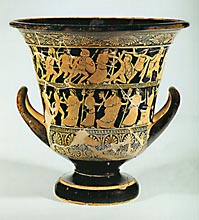The Archaic formal models were not
abandoned overnight. So widespread and so strong were
they, that they were still being used up to the end of
the 5th century to convey monumentality and
excess - mainly in scenes from myth. Early Classical art
offers a contrast with Archaic affectation and the
latter's insistence on details of anatomy and dress. What
it aims at is to portray ethos. By 'ethos'
we normally mean, when speaking of vase-painting, the
intention of expressing a state of mind. This
expression was achieved by increasing the variety and
naturalness of figure poses, and by studied and
harmonious compositions.
In the 470s B.C., there were
a fair number of 'mannerists' at work. They continued
with long-disused technical stereotypes and formalized
clothing. Some painters of large vessels - for instance
the Munich 2413 Painter, successfully freed
themselves from stylized Archaism.
During the second quarter of the 5th century B.C.,
there were important developments in major painting.
The leaders in this field were Polygnotus from Thasos and Mikon
from Athens. One of the most significant innovations was to make
pieces in the shape of great friezes, with the frieze one and a
half times as high as the figures. Mostly the compositions were
free, and had several figures set on different levels (even
though there was no attempt at perspective). These revolutionary
techniques were already being observed and copied by some vase
painters, from 460 B.C. or thereabouts.
The Niobid Painter is both the earliest and
the best representative of the new technique. He is
mainly to be made out from the vase he is named for,
since his other works do not reveal the same approach. On
one side of this vase is a scene which may well be 'The
Argonauts, resting'. On the other is 'the Murder of the
Niobids'. Here we see outstanding examples of the
technique of expressing ethos and pathos so
typical of the art of this transitional period. The
figures are invariably severe in build, their
draughtsmanship careful. Only a hint or two of rocks and
a few sickly plants are there to make up what will one
day be 'landscape'. The Niobid Painter's forte is
drawing figures in three-quarter profile; he also has
some success in depicting simple objects, particularly
shields, in perspective foreshortening. |
 |
Of all the potters of this period, and indeed of the
5th century generally, the most successful craftsman
was Sotades. His work is marked by imagination and
grace, elegance and originality. He mainly made moulded vessels shaped as animal
heads; he also threw figures in a whole solid piece, and groups. Examples are his 'Sphinxes',
'Young African with Crocodile', and 'Easterner with
Camel'. At the same time he was producing a kylix
type with unusually slender handles, and experimenting
with moulded decoration on phialae. He was
in long-term partnership with the painter hence named the
Sotades Painter. |




